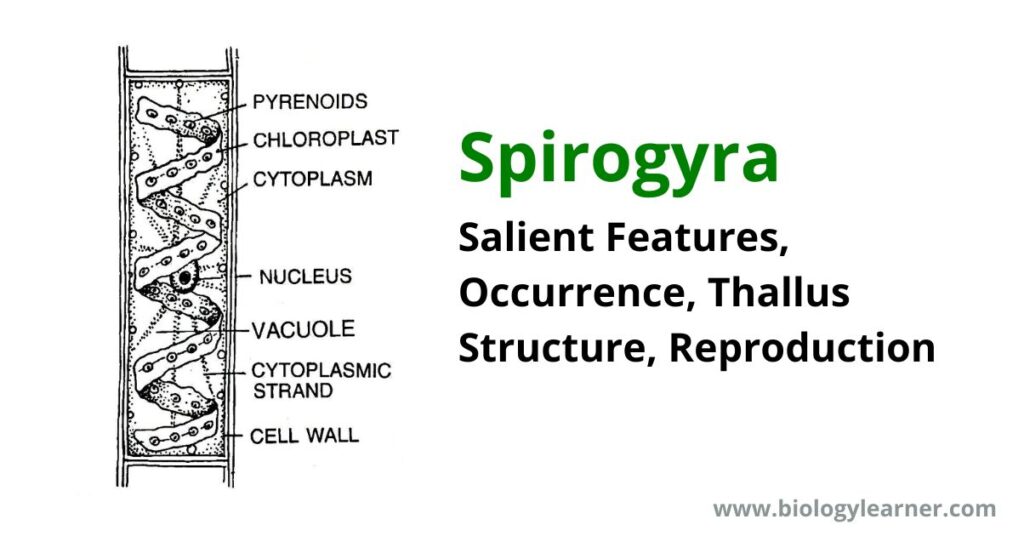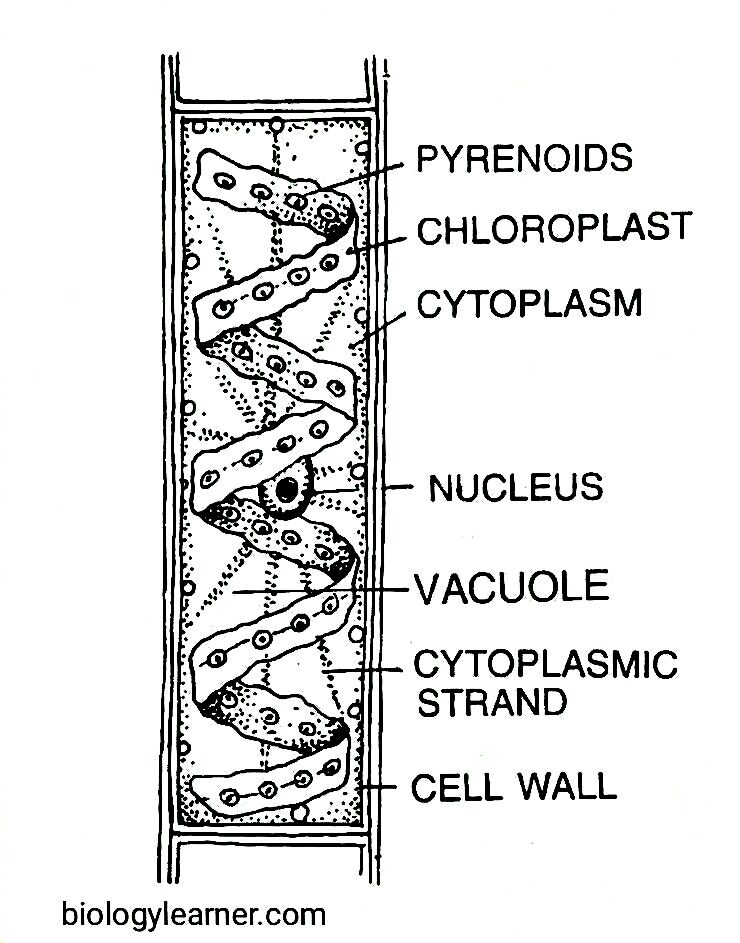Spirogyra is a free-floating, freshwater, filamentous green alga of the class Chlorophyceae. It is usually found in stagnant water bodies such as ponds, pools, ditches, etc.
Spirogyra is also known as water silk or blanket weed, as its filament is slimy in nature.
Salient Features of Spirogyra
The salient features of Spirogyra are as follows:
- The plant body is a green, multicellular, unbranched filament.
- The filament is not differentiated into the base and apex; all the cells are similar in structure.
- Each cell contains one to many spirally arranged, ribbon-shaped chloroplasts.
- Pyrenoids are present at regular intervals in the chloroplast.
- Asexual reproduction is very rare. It takes place by the formation of aplanospores and akinetes in some species.
- Sexual reproduction occurs through conjugation, which is considered a primitive type of isogamy called aplanogametic isogamy.
- Conjugation is of two types, i.e., scalariform and lateral conjugation.
- On germination, the diploid zygospore produces four haploid nuclei, three of which degenerate.

Occurrence of Spirogyra
Spirogyra is a genus in the family Zygnemataceae. It is represented by more than 300 species.
Most of the species are free-floating in freshwater ponds, pools, lakes, tanks, etc. Some species (e.g., S. rhizopus, S. adnata, and S. dubia) remain attached to the substratum with the help of rhizoid-like haptera (Borne, 1894).
Spirogyra adnata is found in slow-running water.
The filaments often form green, tangled masses during and after the rainy season. When the masses come to the surface of the water, they appear as pond scum or pond screen.
- Some Spirogyra species are: S. maxima, S. elongata, S. adnata, S. neglecta, S. affinis, S. dubia, S. rhizopus, etc.
Thallus Structure of Spirogyra
The plant body of Spirogyra is a multicellular, green, unbranched filament. The filament is usually several cm to 1 m long.
Each filament is surrounded by a mucilage sheath, which makes it very slimy. The mucilage often holds the filaments together and forms a tangled mass.
The filament of Spirogyra is composed of many elongated cylindrical cells, arranged in a single row (i.e., uniseriate). The cells are similar in structure. However, the terminal cell is dome-shaped in some species.
In S. fluviatilis, the lower cell (non-green) is modified into a holdfast or hapteron with irregular lobes. Jao (1936) reported non-green rhizoidal outgrowths in some species (e.g., S. rhozopus). The hapteron, or rhizoidal outgrowth, attaches the filament to the substratum.
Cell Structure of Spirogyra
The cells of Spirogyra are cylindrical, placed one above the other in a single row.
Each cell is surrounded by a thick cell wall. The cell wall is bi-layered and consists of an inner cellulosic layer and an outer pectic layer (Randhawa, 1959). The outer pectose layer of the cell wall dissolves in water to form a slimy mucilage sheath, which covers the entire filament.

The cross wall between adjacent cells has a middle lamella, or septum (Prescott, 1969). According to the nature of the middle lamella, the cross wall of Spirogyra may be plane, replicate, semi-replicate, colligate, or unduliseptate.
In replicate type, the middle lamella develops a ring-like ingrowth on either side of the cross wall, while in colligate type, H-shaped pieces form near the middle lamella.
Inner to the cell wall is the protoplast. The protoplast contains the plasma membrane, primordial utricle (a lining layer of cytoplasm, also known as peripheral cytoplasm), a large central vacuole, and a single nucleus.
Most of the interior of the cell is occupied by the large vacuole, which contains cell sap. The single nucleus with a distinct nucleolus is present in the central part of the cell, i.e., the centre of the vacuole.
The nucleus is connected with the primordial utricle by a number of radiating cytoplasmic strands transversely through the vacuole. These radiating cytoplasmic strands hold the position of the nucleus.
In the peripheral cytoplasm, there are a varying number (1–16) of spirally arranged, ribbon-shaped chloroplasts (characteristic of Spirogyra) present. The chloroplast may be serrated or smooth at the margin.
A row of pyrenoids is found at regular intervals in the chloroplast. Each pyrenoid consists of a central protein core surrounded by numerous small starch plates.
Besides the chloroplasts, the primordial utricle also contains various organelles, such as dictyosomes, mitochondria, and the endoplasmic reticulum (Dawes, 1965).
Reproduction in Spirogyra
Spirogyra reproduces mainly vegetatively and sexually. However, asexual reproduction has been observed in a few species.
Vegetative Reproduction
Vegetative reproduction in Spirogyra takes place through fragmentation. It is the most common method of reproduction under favourable conditions.
The filament of Spirogyra can break into small fragments. Each of the broken fragments independently develops into a new filament by repeated cell division.
Fragmentation might occur either due to accidental breakage of the filament (i.e., mechanical injury or insect bites), dissolution of the middle lamella, or the development of H-shaped fragments.
Asexual Reproduction
Asexual reproduction is less common in Spirogyra. It occurs in a few species under unfavourable conditions.
Spirogyra reproduces asexually by the following methods:
Akinetes
In some species (e.g., S. farlowii), the vegetative cells develop a thick wall around them during unfavourable conditions. Such thick-walled cells are called akinetes.
With the onset of favourable conditions, akinete may germinate into a new filament.
Aplanospores
In unfavourable conditions, aplanospores are formed in some species, such as S. aplanospora and S. articulate. These are thin-walled, non-motile spores.
The protoplast of the vegetative cell shrinks, becomes rounded, and secretes a thin wall around it.
The aplanospore comes out of the parent cell and forms a new filament under favourable conditions.
Azygospores
In S. groenlandica, S. rhizoides, and S. varians, sometimes the gametes fail to fuse during sexual reproduction. Such gametes get enclosed by a thick wall and become azygospores or parthenospores.
Each of these spores is also capable of developing into a new filament.



